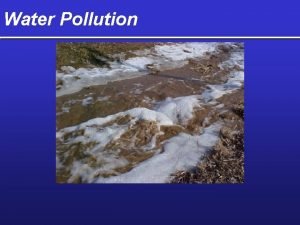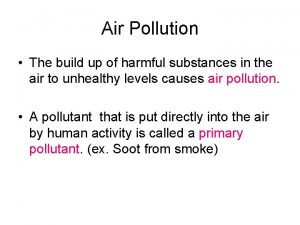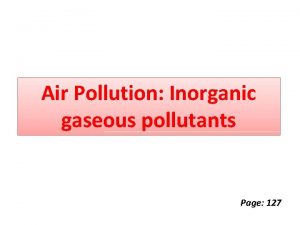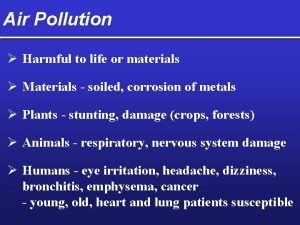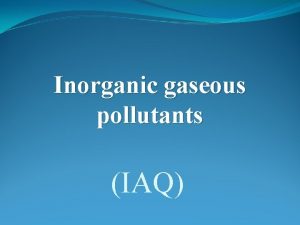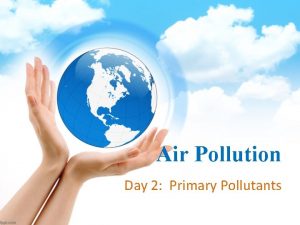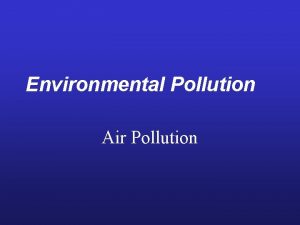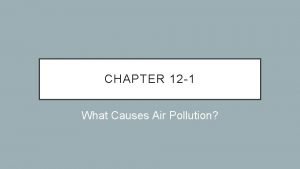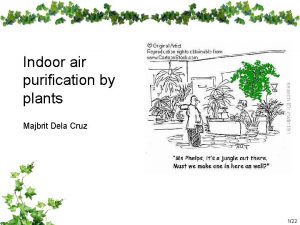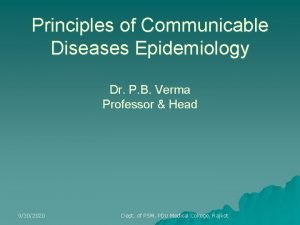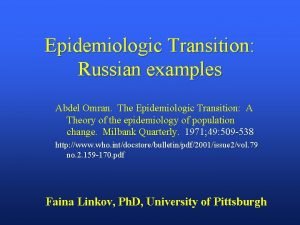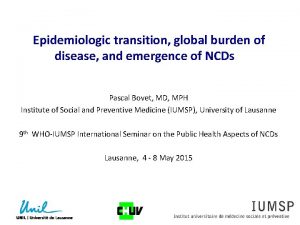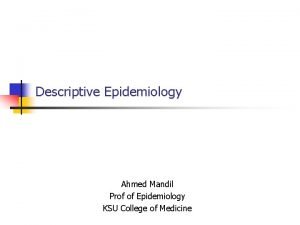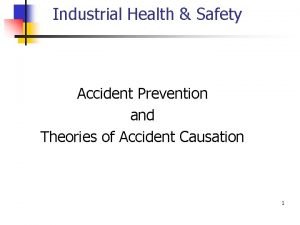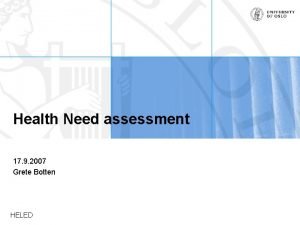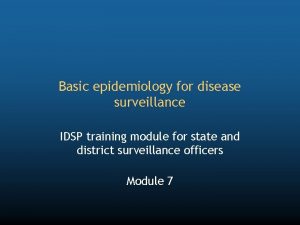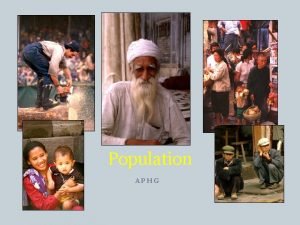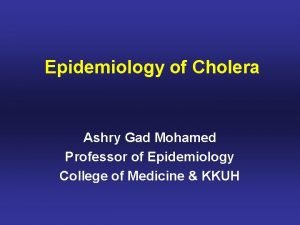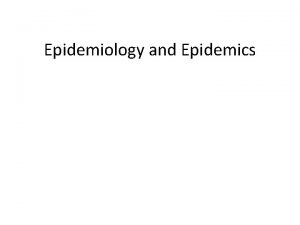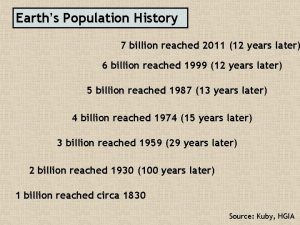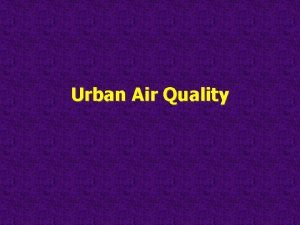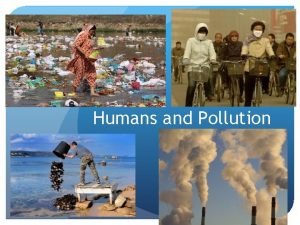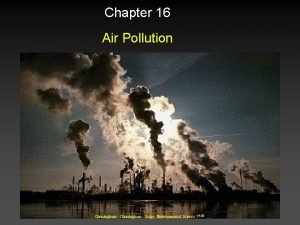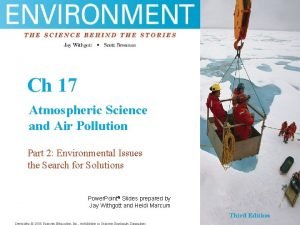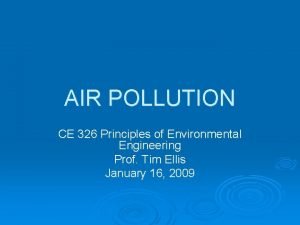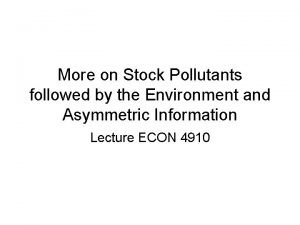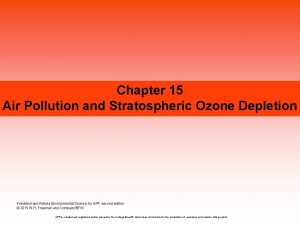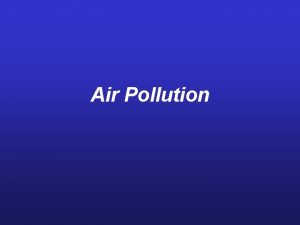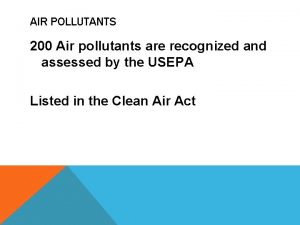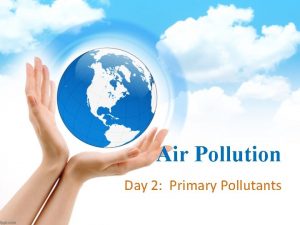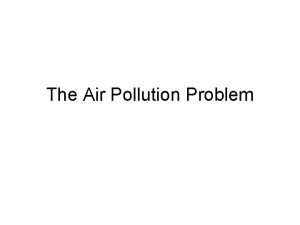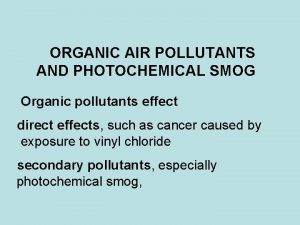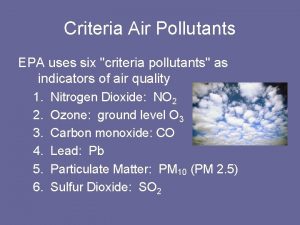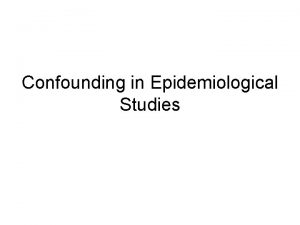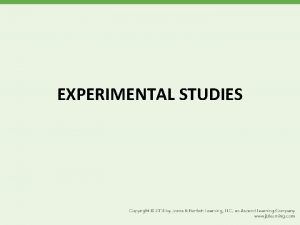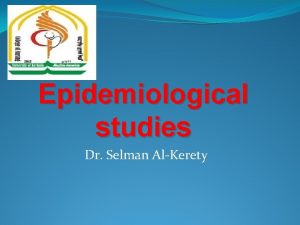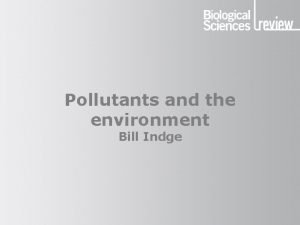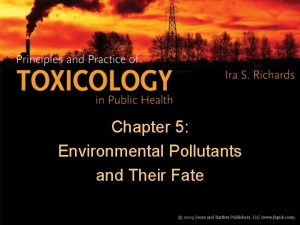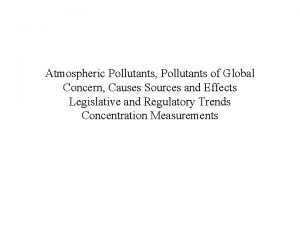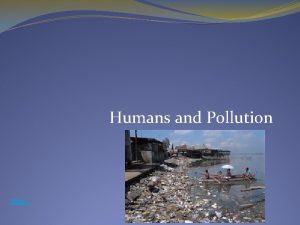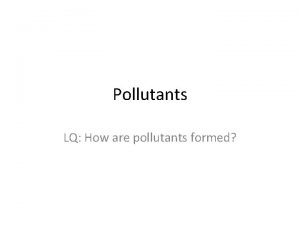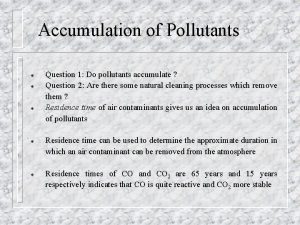An Epidemiological Study on Effects of Air Pollutants




































- Slides: 36

An Epidemiological Study on Effects of Air Pollutants on Respiratory Morbidity among Adults By MANOJ KUMAR Guides Prof. Rajesh Kumar Prof. S. K. Jindal Dr. Madhu Khullar

Air pollution is causing immense concern in India. Ambient Air Quality in Major Cities During 2002 STATE/CITY RSPM Hyderabad Delhi Ahmedabad Banglore Mumbai Chennai Kolkata High Critical High Moderate Critical High Critical Moderate Critical Pollution level RSPM Low (L) 0 -30 0 -70 Moderate (M) 30 -60 70 -140 High (H) 60 -90 140 -210 Critical (C) >90 >210

Effect of London Smog

Acute Effects of Air Pollution Authors Place Effects Schwartz et al. , 1992 London Increase in particulate of 100 g/m 3 was associated with 7% increase in mortality. Schwartz, 1993 Southern U. S. 1. 1 RR was estimated for 100 g/m 3 of inhalable particles levels. Sunyer et al. , 1993 Barcelona An increase of 25 g/m 3 in SO 2 produced 6 to 9% change in emergency room admissions for COPD. Burnett et al. , 1995 Ontario Canada A 13 g/m 3 increase in sulphates was significantly associated with 3. 7% increase in respiratory and 2. 8% increase in cardiac admissions. Damia et al. , 1999 Spain There were approximately 3. 5 admissions a week per 34. 6 g/m 3 change in black smog. Pande et al. , 2002 AIIMS, New Delhi Acute coronary events to the emergency room admissions increased by 24. 3% with increase in air pollution more than permissible limits.

Chronic Effects of Air Pollution Authors Place Effects Deteles et al. , 1987 Los Angeles Association between PM 10 Level & increase in symptoms of respiratory diseases. Spektor et al. , 1988 New Jersey Daily O 3 exposure & humidity were the most explanatory variable for change in lung functions. Ostro et al. , 1991 Denver Cough was associated with foreign particles & shortness of breath. Wong et al. , 1999 Hong Kong Living in the polluted area was associated with poor respiratory health. Zamp et al. , 1999 Switzerland NO 2, TSP, PM 10 was significantly associated with the reported prevalence of cough or phlegm and breathlessness. Peter et al. , 1999 California Wheeze prevalence was associated with levels of SO 2 and NO 2. Frischer et al. , 1999 Germany Long term ambient ozone exposure might negatively influence lung function growth. Kamat et al. , 1992 Bombay Respiratory symptoms were higher in the polluted area i. e. , cough 12% and dysponea 17%. Chhabra et al. , 2001 New Delhi Chronic cough, chronic phlegm & dysponea were significantly common in higher pollution zone, bronchial asthma, COPD & lung function were better in low pollution zone.

Aim The study was aimed to evaluate effects of air pollutants on respiratory morbidity among adults Objectives v. To monitor ambient air quality. v. To estimate the prevalence of respiratory morbidity and lung functions. v. To determine association between air pollution and respiratory morbidity.

Material And Methods Study Design-Cross-sectional study. Ø Household survey for morbidity. Ø Ambient air quality monitoring.

Study Area Mandi Gobindgarh Morinda Study area Reference area Area of 32 Km 2 Area of 7 km 2 Population 55, 400 Population 21, 800 Steel rolling mills and foundries. One sugar mill only.

Sampling Sites v. Mandi Gobindgarh v. Morinda Guru ki Nagri Rest House Colony Prem Nagar Purana Bazar

Sampling Site Map of Mandi Gobindgarh Guru ki Nagri Prem Nagar Map of Morinda

Cluster Sampling Random selection of household and then next nearest household till 500 individuals enrolled from each of study site.

Sample Design Age Groups (years) 20 -29 Male Female 100 30 -39 100 40 -49 100 50 -69 100 70+ 100 Total 500

Study Tools v Questionnaire Respiratory symptoms and diseases, SES (Kuppuswami scale), Household environment, Smoking history, Occupational history v Physical Examination Height (cm. ) Weight (kg. ) Spirometery by portable ventilometer FVC, FEV 1, PEFR, FEV 1/FVC%

Exposure Monitoring 1. Air Sampling-weekly for two years SPM, NOx, SOx, O 3 High Volume Air Sampler Twelve hourly CO Organic Vapors Sampler Eight hourly 1. Meterological data Wind velocity, Temperature and humidity

Data Collection Eligible population Mandi Gobindgarh Morinda Male (N=535) (%) Female (N=523) (%) Male (N=524) (%) Female (N=520) (%) Interviewed Non-Respondents Refused Old age Mentally retarded Away from their family 93. 8 95. 6 96. 1 2. 4 0. 2 2. 0 - 1. 2 0. 3 - 2. 6 - Spirometery Non-Respondents Old age Refused Mentally retarded Paralysis Inability to stand 90. 8 90. 4 91. 6 94. 3 1. 4 3. 2 0. 6 - 0. 2 4. 6 0. 6 1. 0 1. 8 0. 4 0. 6 2. 9 -

Variable Definitions Ø Cough: If an individual usually coughs from his/her chest first thing in the morning. Ø Phlegm: If an individual usually bring up phlegm from his/her chest first thing in the morning. Ø Dysponea: Shortness of breath when walking up a slight hill or others people of his/her age on the level ground or at his/her own pace on level ground or bath, washing or dressing. Ø Wheezing: Whistling sound while breathing.

Ø Chronic bronchitis: If an individual usually has any cough or sputum from his/her chest during the day or night, twice or more, in winter for more than three months in a year, for two consecutive years. Ø Overcrowding: The degree of overcrowding can be expressed, as the number of persons per room, i. e. , number of persons in the household divided by the number of rooms in the dwelling. Ø Year Of Residence: Those who were residing in the town for less than 10 years and others for more than 10 years in the town.

Dust Exposure At Place of Work Ø Mild: idle, shopkeepers, businessmen, secondary education teaching professionals, clerks, sales retail assistants, tailor etc. Ø Moderate: goldsmith, cobbler, electrician, fitter, heavy good vehicle driver, house keeper, halwai, maid servant, farmer, dhaba worker or those who are taking care of animals. Ø Severe: smiths and forges, sheet metal workers, labours in other construction modes, labour in building and wood working, road sweeper, cleaners, motor mechanics, petrol pump worker.

Algorithm For Interpretation Of Spirometry Data Comparison of FEV 1/FVC to its LLN FEV 1/FVC LLN for FEV 1/FVC FEV 1/FVC < LLN for FEV 1/FVC LLN for FVC <LLN for FVC NORMAL STUDY RESTRICTIVE DEFECT OBSTRUCTIVE DEFECT Categorize Using FVC Categorize Using FEV 1 Mild FVC >60% Moderate FVC 40 -60% Severe FVC <40% Mild FEV 1 >60% Moderate FEV 1 40 -60% Severe FEV 1 <40%

Statistical Analysis v Concentration of SPM, SOx, NOx, CO and O 3 was summarised as means and standard deviation. v Prevalence of respiratory symptoms & spirometric airflow limitation v Chi-square test v Student’s t-test v Mantel-Haenszel summary odds ratio v Logistic regression analysis v Interaction between the air pollution and smoking was also included in the models.

Socio-demographic Characteristics of Study Population Variables Higher SES Current Smoking Passive Smoking Dust Exposure Non-LPG fuel use Inadequate lighting Inadequate ventilation Dampness in house Mattress Carpet Presence of insects Overcrowding Mandi Gobindgarh N=1003 (%) Morinda N=1001 (%) 3. 0* 31. 8* 36. 0* 40. 7* 65. 5* 17. 7* 26. 3* 12. 4* 81. 1 54. 5 96. 3 69. 7 11. 8 21. 0 13. 2 26. 7 42. 1 12. 0 17. 8 7. 2 74. 3 47. 6 95. 3 76. 5 *P<0. 05

Air Pollution Levels Ambient Air Pollutants Mandi Gobindgarh SPM ( g/m 3) NOx ( g/m 3) SOx ( g/m 3) O 3 (ppm) CO ( g/m 3) N 115 115 83 115 *P<0. 05 Mean 890. 3* 27. 4* 29. 6* 0. 05* 962. 9* Morinda N 110 110 82 107 Mean 291. 3 7. 4 8. 9 0. 03 113. 9

Prevalence of Respiratory Symptoms Morinda MALES Mandi Gobindgarh FEMALES *P<0. 05

Prevalence of Respiratory Diseases Morinda MALE *P<0. 05 Mandi Gobindgarh FEMALE

Prevalence of Spirometric Abnormalities Male Female Mandi Gobindgarh N=502 (%) Morinda N=501 (%) Mandi Gobindgarh N=501 (%) Morinda N=500 (%) Obstruction 29. 9* 15. 6 25. 2* 12. 4 Restriction 28. 9 23. 8 14. 7 12. 8 *P<0. 05

Prevalence of Cough Variables Age (years) < 45 Smoking Ever Never Fuel use Non-LPG Residence duration (years) > 10 Dust Exposure Mild Moderate to Severe Factory worker Yes No Migrant Yes No Mandi Gobindgarh (%) Morinda (%) 15. 4* 26. 8* 8. 6 17. 0 27. 8* 16. 1* 22. 2 9. 1 21. 9* 16. 5* 14. 0 10. 9 19. 5* 20. 3* 10. 4 12. 9 18. 5* 22. 4* 11. 2 15. 0 20. 0* 12. 2 22. 7* 17. 3* 12. 8 12. 0

Prevalence of Spirometric Obstruction Variables Age (years) < 45 Smoking Ever Never Fuel use Non-LPG Residence duration (years) > 10 10 Dust Exposure Mild Moderate to Severe Factory worker Yes No Migrant Yes No Mandi Gobindgarh (%) Morinda (%) 24. 1* 33. 1* 12. 1 16. 5 32. 9* 24. 7* 26. 4 10. 1 28. 5* 25. 3* 19. 7 9. 9 27. 0* 24. 9* 14. 9 13. 2 27. 8* 27. 2* 12. 2 19. 0 26. 5* 7. 4* 13. 9 - 31. 2* 23. 4* 12. 3 14. 4 *P<0. 05

Association of Ambient Air Quality with Cough (Logistic regression analysis) Variable Poor ambient air quality town Age (years) Sex (male) Higher SES Current smoking Passive smoking Non-LPG fuel use Inadequate lighting Inadequate ventilation Dampness Residence duration Dust Exposure Factory worker Migrant Overcrowding Odds Ratio 1. 59 1. 02 1. 37 0. 99 1. 63 1. 09 1. 45 1. 34 0. 97 1. 01 1. 30 2. 13 1. 05 1. 01 95% C. I. Lower Upper 1. 21 1. 02 0. 96 1. 18 0. 81 1. 08 0. 84 0. 64 0. 71 0. 99 0. 97 1. 41 0. 79 0. 76 2. 12 1. 03 1. 85 1. 04 2. 26 1. 47 1. 96 2. 14 1. 45 1. 62 1. 01 1. 75 7. 1 1. 40 1. 33 P-Value 0. 001 <0. 001 0. 04 0. 9 0. 003 0. 6 0. 01 0. 2 0. 9 0. 8 0. 2 0. 1 <0. 001 0. 7 0. 9

Association of Ambient Air Quality with Obstructive Defects Variable Poor ambient air quality town Age (years) Sex (male) Higher SES Current smoking Passive smoking Non-LPG fuel use Inadequate lighting Inadequate ventilation Dampness Residence duration Dust Exposure Factory worker Migrant Overcrowding Odds Ratio 1. 86 1. 01 0. 86 0. 99 1. 61 1. 11 1. 81 0. 84 1. 16 0. 98 1. 00 1. 05 1. 19 1. 11 0. 87 95% C. I. P-Value Lower Upper 1. 43 1. 00 0. 64 0. 96 1. 17 0. 85 1. 38 0. 55 0. 79 0. 67 0. 99 0. 81 0. 79 0. 85 0. 67 2. 42 1. 01 1. 14 1. 04 2. 21 1. 46 2. 38 1. 27 1. 69 1. 43 1. 01 1. 37 1. 81 1. 45 1. 13 <0. 001 0. 3 0. 9 0. 003 0. 4 <0. 001 0. 4 0. 9 0. 6 0. 7 0. 4 0. 3

Association of Residence in Poor Air Quality with Chronic Respiratory Morbidities Variables Cough Phlegm Dysponea Wheeze C. Bronchitis Asthma Obstruction Restriction Tuberculosis Odds Ratio 1. 59 1. 56 1. 41 1. 50 3. 13 2. 23 1. 86 1. 27 1. 37 95% C. I. P-Value Lower Upper 1. 21 1. 17 1. 09 1. 04 2. 11 1. 10 1. 43 0. 98 0. 57 2. 21 2. 07 1. 78 2. 17 4. 64 4. 53 2. 42 1. 66 3. 29 0. 001 0. 003 0. 07 0. 03 <0. 001 0. 08 0. 5

Summary Ø High level of SPM in study town. Ø Chronic respiratory morbidity was higher in the study town. Ø Smoking, Non-LPG fuel users, Inadequate lighting, Inadequate Ventilation, Dampness and Occupational dust exposure was higher but SES was lower in study town. Ø Stratified analysis shows increased respiratory morbidity in poor air quality town in most of the categories of confounders. Ø Logistic regression analysis reveled that high SPM level is responsible for higher respiratory morbidity even after controlling the effect of age, sex, SES, Smoking, Non-LPG fuel, Inadequate lighting and ventilation, Dampness, Occupational dust exposure.

Study Strength Ø Household survey was done by choosing respondent from community by cluster sampling, thus selection bias was avoided. Ø Information bias was avoided by conducting interview and spirometry using same instrument and same investigator. Ø High response rate (>90%) avoided non-participant bias. Ø The data collection was concurrent in both the town and continued for two years. Thus, including any seasonal variations. Ø Not only inquiry on symptoms was conducting but spirometry was also done according to standard procedure given by A. T. S. and instrument was calibrated monthly.

Study Limitation ØAssessment of air pollution and respiratory health was done at the same time in the study. ØThe occurrence of chronic respiratory disease require exposure to poor air quality for long period of time.

SPM ( g/m 3) Annual Averages of SPM in Mandi Gobindgarh Ø The data collected by the pollution control board shows that the quality of the ambient air in the study town was poor for a numbers of years and most of the migrant workers had resided in the town for considerable period of time.

Conclusion It is concluded that people of Mandi Gobindgarh, which had quite high SPM level, have significantly more symptoms of cough, phlegm, dysponea, wheeze, chronic bronchitis, asthma and have obstructive defects as compared to Morinda which had all air pollutants below permissible level.

THANK YOU
 Primary pollutants and secondary pollutants
Primary pollutants and secondary pollutants Primary pollutants and secondary pollutants
Primary pollutants and secondary pollutants Primary vs secondary pollutants
Primary vs secondary pollutants Inorganic gaseous pollutants of air
Inorganic gaseous pollutants of air Secondary air pollutants
Secondary air pollutants Inorganic gases
Inorganic gases What are the secondary air pollutants
What are the secondary air pollutants Major air pollutants
Major air pollutants Air pollutants
Air pollutants Indoor air pollutants
Indoor air pollutants Air higroskopis air kapiler dan air gravitasi
Air higroskopis air kapiler dan air gravitasi Epidemiological triad
Epidemiological triad The wheel model of disease causation
The wheel model of disease causation Stages of epidemiological transition
Stages of epidemiological transition Abdel omran
Abdel omran Obesity and bone health
Obesity and bone health Epidemiological triad
Epidemiological triad Human factor theory
Human factor theory What is epidemiological approach
What is epidemiological approach Epidemiological triad
Epidemiological triad What is epidemiological approach
What is epidemiological approach Diagnosis epidemiologi
Diagnosis epidemiologi Epidemiological transition model stage 2
Epidemiological transition model stage 2 Stages of demographic transition
Stages of demographic transition Rickettsia vitamin d
Rickettsia vitamin d Epidemiological transition model
Epidemiological transition model Cholera
Cholera Epidemiology triangle
Epidemiology triangle Cross sectional study advantages and disadvantages
Cross sectional study advantages and disadvantages Dtm
Dtm Secondary pollutants examples
Secondary pollutants examples Primary and secondary pollutants
Primary and secondary pollutants Primary vs secondary pollution
Primary vs secondary pollution Copyright
Copyright Primary vs secondary pollutants
Primary vs secondary pollutants Stock pollutants
Stock pollutants Primary and secondary pollutants difference
Primary and secondary pollutants difference
